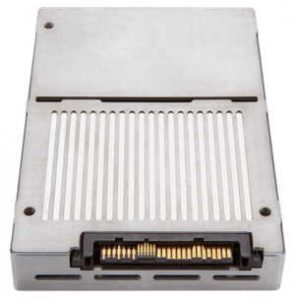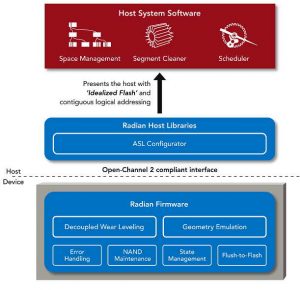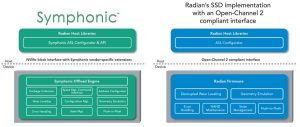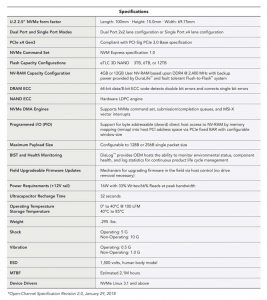FMS: Radian Memory Systems Unveils RMS-350 Open-Channel 2 Compliant Up to 12TB U.2 SSD
Includes support for Cooperative Flash Management based on Symphonic CFM technology, targeting AFAs, hyperconverged systems and cloud storage, offers highly parallelized, deterministic I/O while minimizing tail latencies for data center workload.
This is a Press Release edited by StorageNewsletter.com on August 3, 2018 at 2:30 pmRadian Memory Systems, Inc. releases the industry’s first Open-Channel 2 (*) (OC2) compliant flash SSD in a U.2 form factor with up to 12TB of flash, and includes up to 12GB of byte addressable, PMR style user NV-RAM.

Targeting all-flash arrays, hyperconverged systems, and cloud storage, the RMS-350 SSD offers highly parallelized, deterministic I/O while minimizing tail latencies for data center workloads. This includes support for Cooperative Flash Management (CFM) based on the company’s Symphonic CFM technology or the company’s implementation of the Open-Channel 2 interface.
Click to enlarge
Variations of software-defined, Open-Channel SSDs are gaining traction throughout hyperscale. With early versions deployed by Baidu, Inc. and Alibaba Group Holding Limited, in China, other variations, such as a future proposal by Microsoft Azure for their Project Denali, are anticipated to be available within the next year.
Founded in 2010, Radian has pioneered what is known as Cooperative Flash Management (CFM) technology.
“With the RMS-350, we’re leveraging some of our innovative Cooperative FlashManagement functionality to bring datacenter functionality into an SSD with an Open-Channel 2 compliant interface“, said Mike Jadon, CEO, Radian.
While this firm functionality has been available in the company’s Symphonic SSDs for several years, the RMS-350 represents the first SSD to include it and numerous other features in an SSD with an Open-Channel 2 compliant interface:
Software/firmware:
-
Idealized flash
-
-
Geometry emulation abstracts NAND geometry and vendor-specific attributes
-
Maintains alignment to the physical memory array
-
Abstracts device’s internal management of bad blocks
-
Presents ‘Idealized flash’ to the host
-
-
-
ASL configurator
-
-
Address Space Layout configurator presents hosts with contiguous logical addressing (no gaps) for direct access by modern host software stacks
-
Can subdivide NAND memory into iso-boxes that appear like independent block devices
-
Optimizes opposing performance and efficiency trade offs unique to flash memory
-
-
-
Cooperative and ‘decoupled’ wear leveling
-
-
Controller generates wear related metrics and makes them accessible to the host
-
Different host-owned, memory controller-owned and shared cooperative modes to offload and simplify host controlled wear leveling
-
Enables vendor supported warranties
-
-
-
Cooperative and ‘decoupled’ NAND maintenance
-
-
Device handles low level NAND maintenance activities for data retention and to prevent disturbs
-
Performs these activities cooperatively under deterministic host scheduling to minimize unpredictable latency spikes
-
-
Hardware:
-
Up to 12GB of PMR style, byte addressable NV-RAM with its up to 12TB of flash
-
Dual port or single port with hot plug/surprise remove
-
Fault tolerant design
-
U.2 form factor
The company publicly released Symphonic, the first implementation of a CFM architecture, in 2015. As the winner of the Most Innovative Technology award at the 2015 Flash Memory Summit conference,
Symphonic: “redistributes functionality and responsibilities between the host system and SSD. Built on the premise of operating in host address space, Symphonic leverages the intelligent segment cleaning and macro scheduling that the host is already performing. This enables the host to control and schedule processes such as garbage collection, but offloads process execution and lower level media management to the SSD.“ (**)
Click to enlarge
The RMS-350 utilizes this firm’s technology, including the ‘Idealized flash’, ASL Configurator, Cooperative and ‘Decoupled’ Wear Leveling, Cooperative and ‘Decoupled’ NAND Maintenance and other Radian features to deliver an SSD with data center functionality that retains software-defined, host data layout and deterministic host scheduling with an Open-Channel 2 compliant interface.
Hardware
The RMS-350 is available in flash capacities of 3, 6 or 12TB, along with 4 or 12GB of PMR style User NV-RAM. The NVMe PCIe Gen3 interface supports dual port 2×2 or single port x4 lane configurations. The drive’s enterprise TLC NAND (eTLC) is supported by a robust LDPC error correction engine.
The 4 or 12GB of PMR style User NV-RAM provides functionality similar to an on-board NV-DIMM-N, but unlike a NV-DIMM, scales with Flash capacity as drives are added to a system, and does so without cabling to remote capacitor packs. This NV-RAM appears as an independent NVMe block device that can be accessed via NVMe, or memory mapped (mmap) as byte accessible (dword) memory for Programmed I/O (PIO).
The RMS-350 includes HA features such as dual port, hot plug/surprise remove, fault tolerant memory management, and comprehensive diagnostic lifecycle capabilities to meet data center and enterprise OEM requirements.
RMS-350 evaluation units are available to select customers and availability is scheduled for fall 2018.
The company will be exhibiting at the Flash Memory Summit, August 7, 2018.
Click to enlarge
(*) Open-Channel Specification Revision 2.0, January 29, 2018
(**) Symphonic Product Brochure – Published/Copyright August 2015
















 Subscribe to our free daily newsletter
Subscribe to our free daily newsletter

